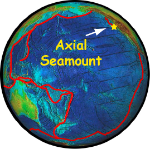
Axial Seamount Expeditions
Axial Seamount is the most active submarine volcano in the NE Pacific. It rises to a depth of 1400 m below sea level and is located about 300 miles off the coast of Oregon. Axial Seamount was the site of the world's first underwater volcano observatory called NeMO and has erupted most recently in 2015, 2011 and 1998. Because it is so active, Axial has been chosen as a key node on a new cabled observatory, which is part of the National Science Foundation’s Ocean Observatory Initiative (OOI). Plots of real-time data from the OOI Cabled Array are available -> HERE. Follow our attempts to forecast when it will erupt next -> HERE.
 |
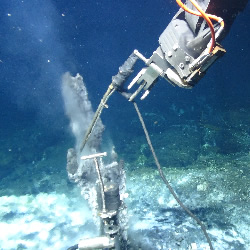 |
 |
| 3D image of Axial Seamount bathymetry. | ROV Jason sampling a hydrothermal vent inside Axial's caldera. | Ocean Bottom Hydrophone (OBH) buried by the recent lava flow. |
 |
| R/V Atlantis at Axial Seamount in 2024. Photo by Marley Parker. |
2024 Expedition
The 2024 expedition to Axial Seamount was June 21-July 2 aboard the R/V Atlantis, with ROV Jason and AUV Sentry on board. We repeated the pressure measurements and AUV bathymetry lines documenting the inflation of the volcano since its last eruption 2015. We also deployed 6 new seafloor benchmarks to better document inflation in the northern half of the caldera.
This year we had freelance science reporter Marley Parker out with us, and she wrote a blog post for the NDSF website and created a video summary of the expedition. She also wrote two additional blog posts on her own website with additional photos: HERE and HERE.
A link to the Axial 2024 cruise report will be posted here when it is ready...
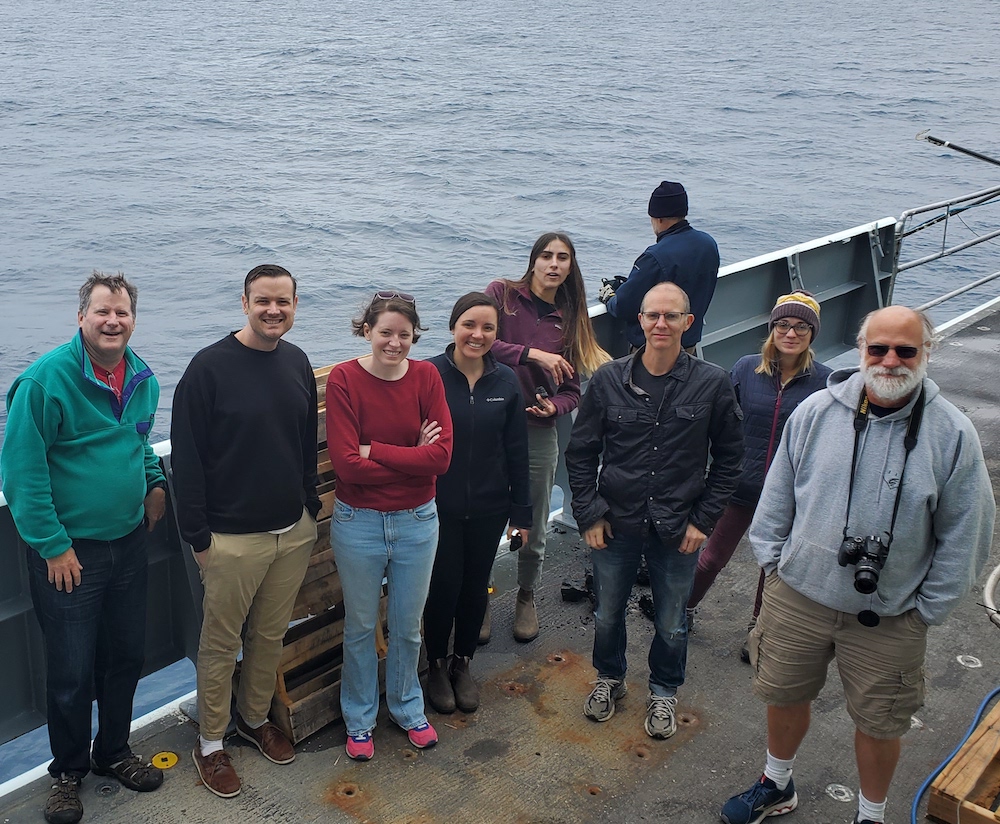 |
| Axial 2022 Science party aboard the R/V Thompson. |
2022 Expedition
The 2022 expedition to Axial Seamount took place June 19-July 2 aboard the R/V Thompson, once again with ROV Jason and AUV Sentry on board. We made our time-series measurements of the inflation of the volcano and collect high-resolution repeat bathymetry with the AUV. We deployed 4 new pressure benchmarks to see whether there is slip occuring across the caldera faults. Also we successfully tested and integrated Terrain Relative Navigation software on AUV Sentry, which allowed it to navigate itself relative to previously collected bathymetry.
This year we had Oregon Public Broadcasting (OPB) reporter Jes Burns and videographer Stephani Gordon out with us, and they produced a fun and informative episode of "All Science, No Fiction" about our work, and a full episode of the OPB TV show Oregon Field Guide. Three parts of the show are on YouTube: HERE, HERE, and HERE.
The Axial 2022 cruise report is available: HERE
 |
| Axial 2020 Science party aboard the R/V Thompson. |
2020 Expedition
The 2020 expedition to Axial Seamount took place September 1-20 aboard the R/V Thompson, with ROV Jason and AUV Sentry on board. The main goal, again, was to continue time-series measurements of the volcanic inflation of the submarine volcano and collect high-resolution repeat bathymetry with the AUV. This expedition was unusual since it occurred during the COVID-19 epidemic, involving pre-cruise quarantine and COVID testing for everyone getting on the ship. Wildfires in Oregon along with strong easterly winds blew smoke (and land birds) out to the ship during the cruise.
Follow the Axial 2020 cruise blog on the UW Interactive Oceans web site.
The Axial 2020 cruise report is available: HERE
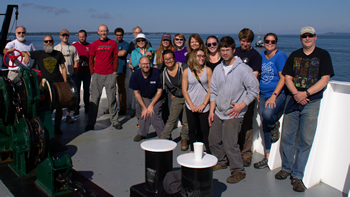 |
| 2018's Science participants aboard the R/V Kilo Moana. |
2018 Expedition
2018's expedition to Axial Seamount took place August 18-27 aboard the R/V Kilo Moana, with ROV Jason and MBARI's mapping AUV. The main goal was to continue measurements of the volcanic inflation of Axial Seamount and collect high-resolution bathymetry with the AUV.
Follow the expedition at the Axial 2018 blog (axial2018.blogspot.com).
Axial 2018 cruise report available: with dive logs (pdf) or without dive logs.
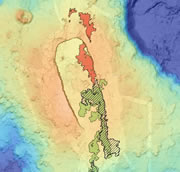 |
| 2015-2011-1998 lava flows inside Axial's caldera. |
2017 Expedition
The 2017 expedition to Axial Seamount was on R/V Revelle, July 13-23, with ROV Jason and AUV Sentry on board. On this expedition we made measurements to monitor the continued re-inflation of the volcano since its last eruption in 2015 so we can better understand how magma is supplied and stored within the volcano, how it fuels hydrothermal vents and their biological communities, and how we can refine forecasts of future eruptions. We also sampled hydrothermal vents to continue a time-series aimed and understanding the interactions between volcanic events and the hydrothermal and biological systems.
Review the expedition at the Axial 2017 blog (axial2017.blogspot.com).
Axial 2017 cruise report available: with dive logs (pdf 4.2 MB) or without dive logs (pdf 2.5 MB).
2016 Expedition
EOI scientist Bill Chadwick participated in a cruise to Axial Seamount on R/V Wester Flyer with colleagues at the Monterey Bay Aquarium Research Institute (MBARI), August 8-16, 2016. The cruise explored and sampld some of the 2015 lava flows that had not previously been visited and utilized new AUV bathymetry collected this summer over the new lava flows. More information from the cruise web site:
http://www.mbari.org/at-sea/expeditions/northern-2016-expedition/
 |
| 3D view of Axial Seamount and the 2015 lava flow on the north rift zone. |
2015 Expedition
Exploration of the 2015 lava flows at Axial Seamount
The 2015 expedition to Axial Seamount was August 15-29 aboard the R/V Thompson. The cruise successfully conducted operations with the underwater vehicles ROV Jason and AUV Sentry. The big excitement this year was exploring the April-May 2015 Axial Seamount eruption and conducting extensive exploration, mapping, and sampling of the new lava flows.
Explore the results of the expedition with the Axial 2015 blog (axial2015.blogspot.com).
Axial 2015 cruise report available: with dive logs (pdf 6.2 MB) or without dive logs (pdf 3.3 MB).
(Note: Cruise report was revised May 2016 with updated navigation informtation for J2-826).
2014 Expedition
The 2014 expedition was August 10-19 on the NOAA Ship Ron Brown with ROV Jason. The dives deployed instruments and collected samples to study the long-term evolution of the hydrothermal system, subsurface microbial and viral communities, and an experiment to test the feasibility of geothermal energy extraction from hydrothermal vents.
Axial 2014 Cruise report: pdf
2013 Expedition
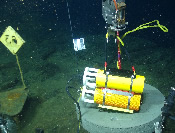 |
| Pressure instrument recording the inflation of the caldera. |
Rapid reinflation found at Axial Seamount
During an expedition to Axial Seamount in September 2013, EOI scientists discovered that the inflation rate since the 2011 eruption was higher than expected, totaling 1.57 m of reinflation since the April 2011 eruption. This is an average uplift rate of 61 cm/yr, much higher than the 15 cm/yr seen during most of the period between the 1998 and 2011 eruptions. Overall, this means that Axial has already recovered 65% of the -2.4 m of deflation that was measured during the 2011 eruption. If this high inflation rate continues, Axial will be back to its pre-2011 level of inflation by January 2015, or if the rate of inflation slows down to rates more like those between 1998-2011, then the pre-2011 level of inflation will not be reached until ~2018. This means that Axial’s next eruption could occur sooner than expected. These results show the importance of continued monitoring at Axial, because it is still providing new insights and surprises.
More information, images, and video clips are available at the Axial2013 cruise web site.
Axial 2013 cruise report available: with dive logs (pdf 13MB) or without dive logs (pdf 5.7MB).
2012 Expedition and publication of papers about the 2011 eruption
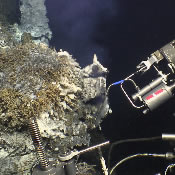 |
| Sampling the fluid from Hell vent at Axial. |
Precursors to Eruption at Axial Seamount Found
Three papers published in the journal Nature Geoscience present recent results about the 2011 eruption at Axial Seamount, authored or co-authored by EOI scientists. One paper describes the inflation/deflation cycle of the volcano leading up to and during the eruption. A second paper reports on the pattern of earthquakes before and during the eruption recorded by ocean bottom hydrophones. The third paper by colleagues at MBARI reveals the 2011 lava flows in remarkable detail, based on comparison of high-resolution mapping before and after the eruption. The journal also published a "News and Views" article describing the significance of the three papers.
Both the inflation and hydrophone recordings showed long-term and short-term precursors to the 2011 eruption that could be used to forecast future eruptions at Axial Seamount. This is particularly important because Axial will soon be the site of a cabled observatory, as part of NSF's Ocean Observatories Initiative, that will make real-time monitoring of the volcano possible for the first time. NOAA EOI scientist have designed and built some of the instruments that will be connected to the cable at Axial.
Axial 2012 cruise report (pdf)
NOAA Research News: Underwater ears heard rumblings before 2011 undersea volcano eruption (June 11, 2012)
2011 Expedition
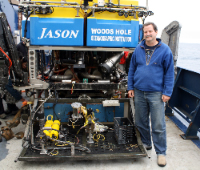 |
|
Bill Chadwick stands next to the remotely operated vehicle Jason on the deck of the research vessel Atlantis after the dive that discovered the new lava flow on the seafloor at Axial Seamount. (Photo credit: Scott Nooner) |
Eruption Discovered at Axial Seamount
NOAA EOI Program scientists discovered a newly erupted lava flow at Axial Seamount.
Dr. Bill Chadwick, an Oregon State University scientist with the Cooperative Institute for Marine Resource Studies along with Dr. Dave Butterfield, a University of Washington scientist with the Joint Institute for the Study of the Atmosphere and Oceans, made the discovery aboard the R/V Atlantis with the Jason remotely operated vehicle (ROV), on an expedition jointly funded by NOAA and the National Science Foundation.
A Jason dive on July 28 discovered the new lava flow, and bottom pressure recording and ocean bottom hydrophone instruments recovered show that the eruption occurred on April 6, 2011. The last eruption at Axial Seamount occurred 13 years ago in 1998. Dr. Chadwick and colleague Scott Nooner from Columbia University had forecast an eruption at Axial Seamount before 2014, based on time-series measurements of volcanic inflation using bottom pressure measurements. This is the first time that a successful eruption forecast has ever been made for a submarine volcano, and confirms that Axial Seamount is an excellent location for state-of-the-art studies of active submarine volcanic processes and how they impact ocean physical, chemical, and biological environments.
The 2011 expedition cruise report is available here (pdf).
Oregon State University Press Release: Scientist find eruption at undersea volcano (August 9, 2011)
National Science Foundation Press Release: NSF Ocean Observatories Initiative Streams Live Viedo of Undersea Volcano
  
|
Axial Educational Resources:

|
| Octopus on the 2015 new lava flow (Click for video). |
Video Collection:
Earth-Ocean Interactions Axial Seamount YouTube Playlist
Videos from EOI Program's expeditions to the seafloor using remotely operated vehicles are available now on YouTube.
More Information on previous expeditions to Axial Seamount:
Some previous expeditions to Axial Seamount are described on the New Millenium Observatory (NeMO) web site.
Expedition Websites: 2017 | 2016 | 2015 | 2013:Thompson - Falkor | 2007 | 2006 | 2005 | 2004 |2003 |2002 | 2001 | 2000 | 1999 | 1998
Cruise Reports: (pdf files) 2016 | 2015 | 2014 |2013 | 2012 | 2011 | 2010 | 2007 | 2006 | 2005 | 2004 | 2003 | 2001 | 2000 | 1999 |1998
